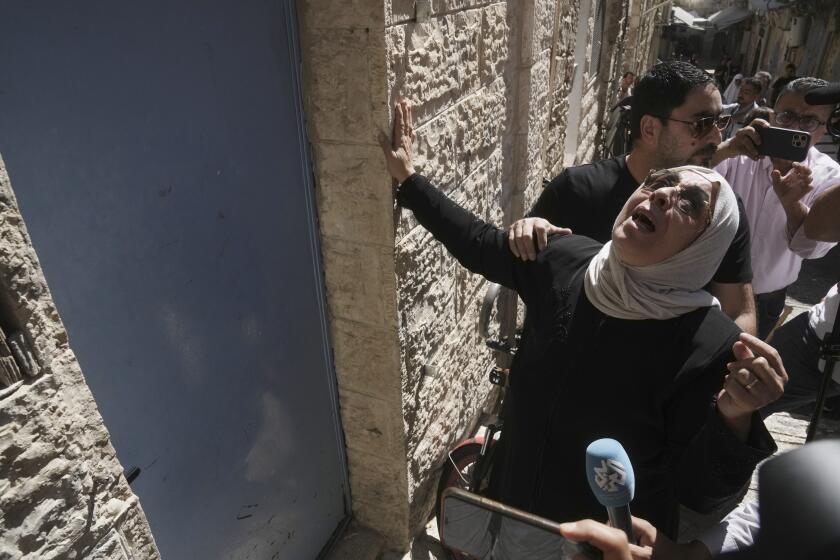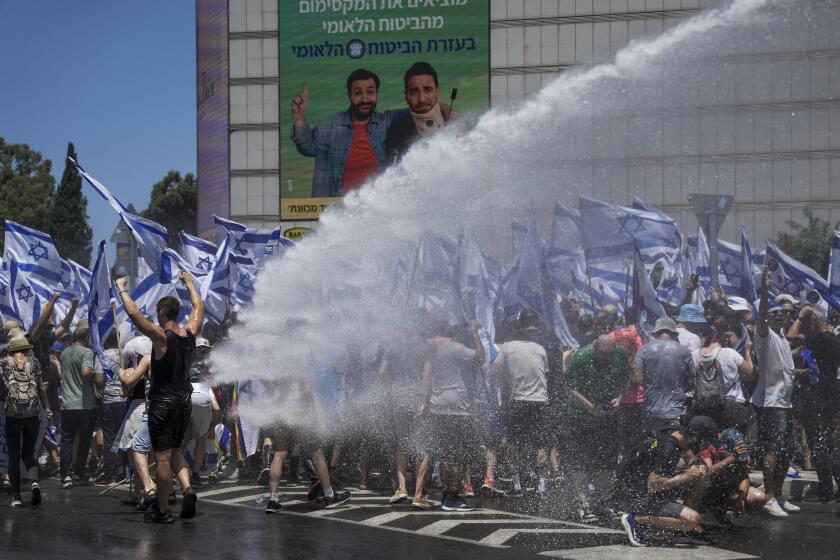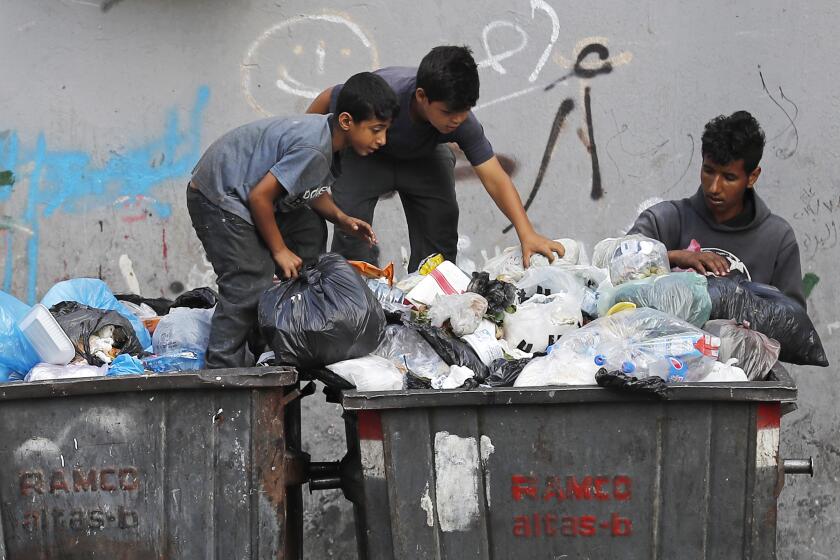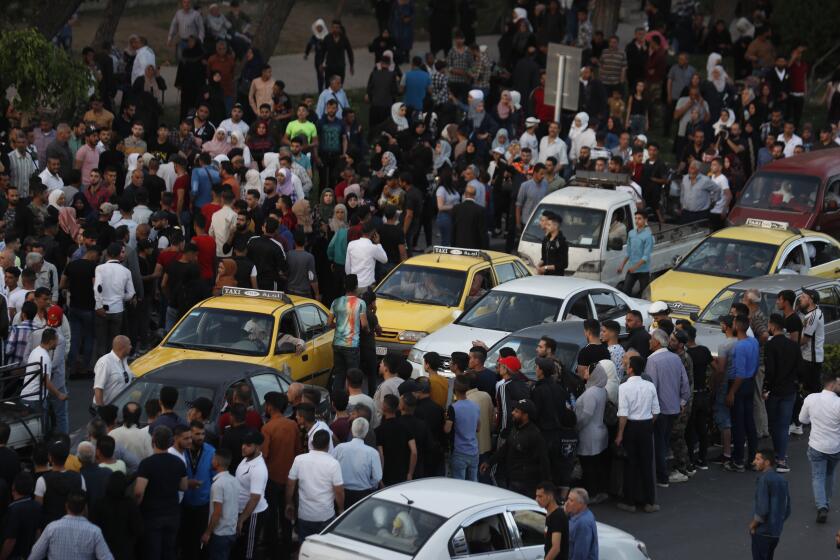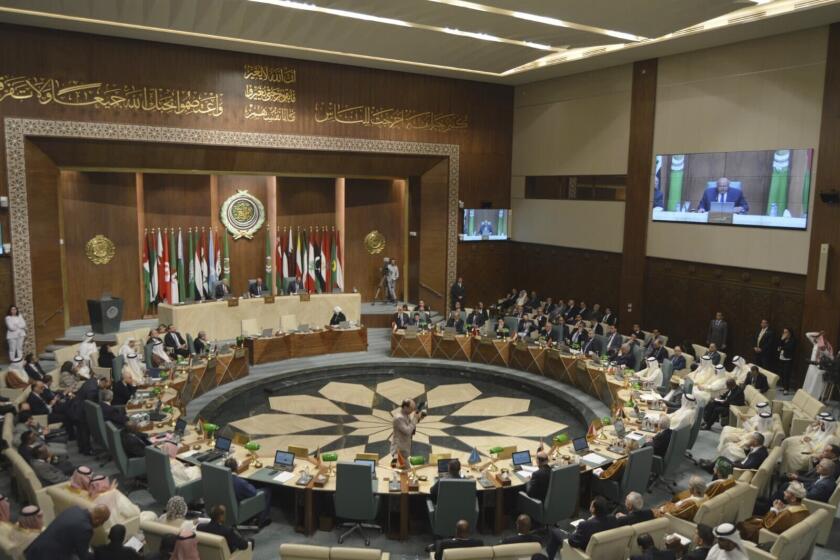Growing tensions over Israel-Lebanon border village fuel fears of more violence
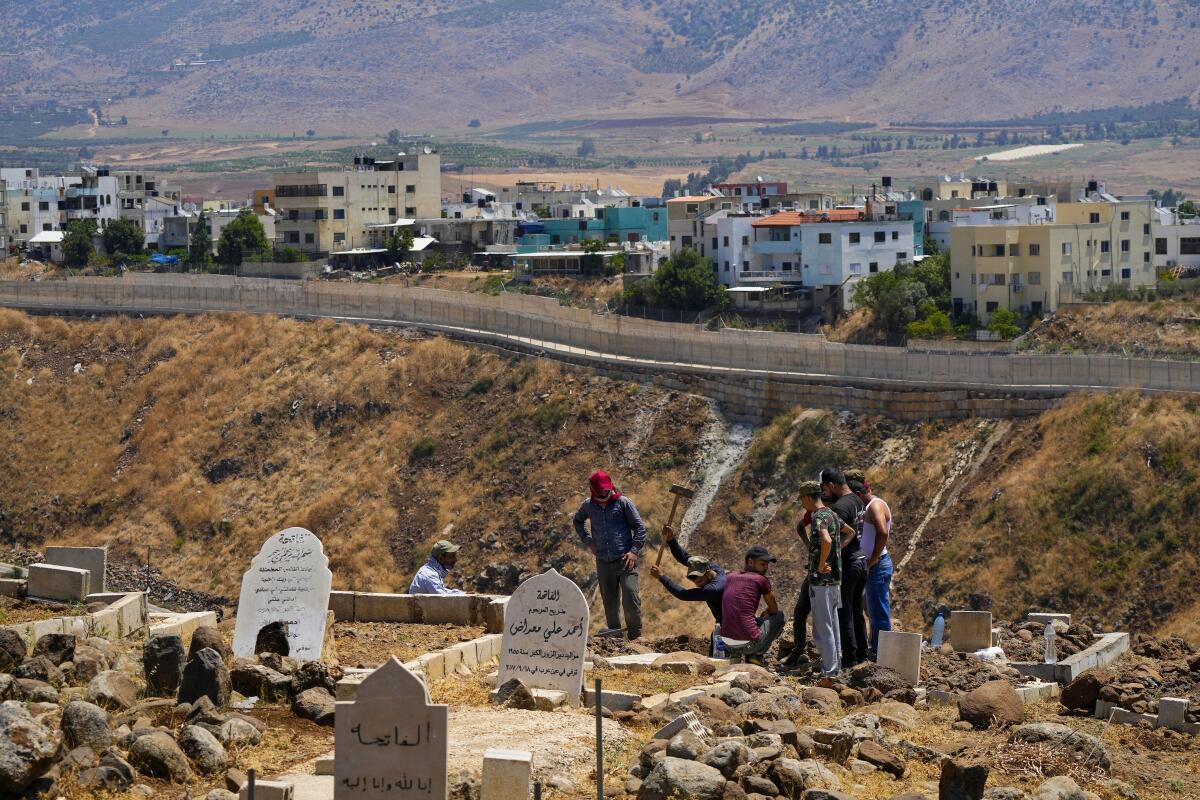
- Share via
KFAR CHOUBA, Lebanon — The little village of Ghajar has been a sore point between Israel and Lebanon for years, split in two by the border between Lebanon and the Israeli-occupied Golan Heights. After a long period of calm, the dispute has begun to heat up again.
Israel has been building a wall around the half of the village in Lebanese territory, triggering condemnation from the Lebanese militiant group Hezbollah, which accuses Israel of moving to annex the site. A recent exchange of fire in the area raised alarm that the dispute could trigger greater violence.
The growing tensions over Ghajar add to the jitters along the Lebanese-Israeli border, where Israel and Iranian-backed Hezbollah fought a destructive 34-day war in the summer of 2006. The two sides have studiously avoided outright battle ever since, despite frequent flare-ups of tension — but each constantly says a new conflict could erupt at any time.
The dispute over a small village in the green hills where Lebanon, Israel and Syria meet brings a new point of worry amid broader unrest in the Mideast. The occupied West Bank has seen increased bloodshed in recent months, including a major two-day offensive last week that Israel says targeted Palestinian militants. Within Israel, moves by the far-right government to overhaul the judicial system have sparked large anti-government protests.
“This is Lebanese land, not Israeli,” said Lebanese shepherd Ali Yassin Diab, pointing to the half of Ghajar being enclosed by the Israeli wall as his sheep and goats grazed nearby. Members of the United Nations peacekeeping force, UNIFIL, watched from a distance. In the early 2000s, Yassin used to take his herds to drink at a pond there but has since been cut off.
The village’s division is an unusual byproduct of the decades of conflict between Israel and its neighbors.
Activists say the Ghaith-Sub Laban family’s removal is part of a trend of Israeli settlers encroaching on Palestinian neighborhoods in East Jerusalem.
Ghajar was once part of Syria but was captured by Israel in the 1967 Mideast War as part of Syria’s Golan Heights, which Israel occupied and later annexed, with little world recognition.
In the 1980s and 1990s, Ghajar’s population expanded north into nearby Lebanese territory, held by Israel in its 18-year occupation of southern Lebanon. When Israel withdrew from Lebanon in May 2000, U.N. surveyors delineating temporary borders ruled that Ghajar’s northern part was in Lebanon and its southern part in the Golan, dividing it in two.
Six years later, Israeli troops moved into the northern part of Ghajar during the Israel-Hezbollah war. They have occupied it since, and a fence was installed preventing people from entering it from Lebanon. Under the truce that ended the 2006 fighting, Israel agreed to withdraw from Ghajar, but it wanted to clinch an arrangement to keep Hezbollah from entering the village.
In a statement to the Associated Press on Friday, the Israeli Foreign Ministry said that Israel recognized the line dividing the village in 2000 but that, following the division, “Hezbollah established itself in the village” and attempted to abduct an Israeli soldier.
Protesters in Israel thronged the country’s main international airport in a day of countrywide demonstrations against the government’s divisive plan.
Most of Ghajar’s around 3,000 residents hold Israeli nationality — some of them alongside Lebanese — and they largely identify as Syrians.
Last year, Israel started erecting a concrete wall around the northern part of the village. It also began encouraging Israeli tourism to the village. In its statement, the Foreign Ministry said the wall “is on the same route as the fence that was in place before” around the village.
In apparent reply to the near-finishing of the wall, Hezbollah set up two tents nearby, including one in the area of Shebaa Farms, which Israel and Lebanon each claim as its territory. It is not clear what is inside the tents.
Israel filed a complaint with the U.N., claiming that the tents were several dozen yards inside Israeli territory. Hezbollah says the tents are in Lebanese territory.
One person’s trash is definitely another person’s treasure in Lebanon, but record inflation and the tanking economy have made finding it a lot harder.
On Monday, UNIFIL’s commander relayed an Israeli request to Lebanon’s caretaker prime minister and parliament speaker to remove the tent. They responded that Israel should withdraw its troops from the Lebanese part of Ghajar, according to Lebanese Foreign Minister Abdallah Bouhabib.
Hezbollah leader Sayyed Hassan Nasrallah said in a speech Wednesday night that Israel had cordoned off Ghajar before Hezbollah set up its tents.
“Over the past days, it became clear that they [Israel] have annexed it,” Nasrallah said. He added: “The land of Ghajar will not be left for Israel, and certainly not Shebaa Farms and Kfar Chouba,” another border area claimed by both countries.
A resident of Ghajar, speaking to the AP on condition of anonymity out of security concerns, said that the villagers considered themselves Syrian but that their main concern was “to stay in Ghajar, in this village, living in peace and security, no matter under who rules.”
Start your day right
Sign up for Essential California for the L.A. Times biggest news, features and recommendations in your inbox six days a week.
You may occasionally receive promotional content from the Los Angeles Times.
“There is a [border] line that was drawn by the United Nations. Why are they allowed to cross it while we as Lebanese citizens cannot?” Mohammed Rammal, the mayor of the nearby Lebanese border village of Oddeissi, said of Israel’s presence in Ghajar.
Last week, an antitank missile was fired from Lebanon near Ghajar, with some fragments landing in Lebanon and others inside Israeli territory. Israel fired shells on the outskirts of nearby Kfar Chouba.
On Wednesday, an explosion elsewhere near the border slightly wounded at least three Hezbollah members. Nasrallah said the case was still under investigation. Late last month, Hezbollah said it shot down an Israel drone flying over a village in southern Lebanon.
On Monday, Israeli Prime Minister Benjamin Netanyahu met with President Biden’s special envoy for energy, Amos Hochstein, during which they discussed “regional issues,” according to Netanyahu’s office.
The families of some of the tens of thousands of people missing in Syria are drawing some hope from a new U.N. push to find their loved ones
Some Israeli media said Netanyahu and Hochstein, who helped broker a maritime border deal last year between Israel and Lebanon, discussed tensions along the border with Lebanon.
“We continue to monitor and engage with authorities in Lebanon and Israel on the issue of Ghajar,” UNIFIL spokeswoman Kandice Ardiel said. She added that UNIFIL has repeatedly called on Israel to stop its works north of the line and that Israel’s occupation of northern Ghajar violates the U.N. Security Council resolution ending the 2006 war.
Israel considers Hezbollah its most serious immediate threat, estimating that it has some 150,000 rockets and missiles aimed at Israel.
During a tour by an Associated Press team near Ghajar this week, more patrols by U.N. peacekeepers and the Lebanese army along the border were visible. Residents in nearby villages appeared defiant and to be going on with life as usual during the summer season, when many expatriates come to spend time with their families.
The Arab League has agreed to reinstate Syria, ending a 12-year suspension of the nation led by Bashar Assad.
In Lebanese media, many analysts say neither side wants a new war. But Lebanese political analyst Faisal Abdul-Sater warned that the situation was precarious, with Israel and Hezbollah both on alert.
“Whoever fires the first shot will bear the responsibility for the consequences,” he said.
More to Read
Sign up for Essential California
The most important California stories and recommendations in your inbox every morning.
You may occasionally receive promotional content from the Los Angeles Times.
